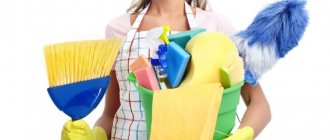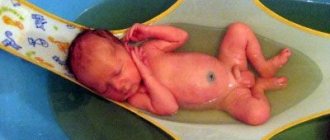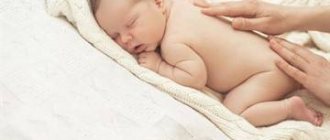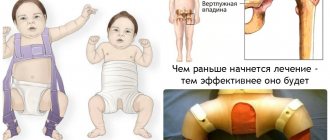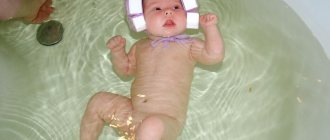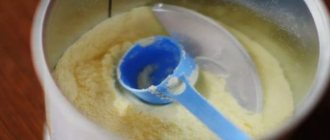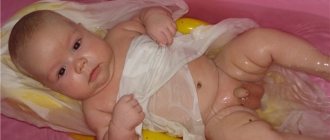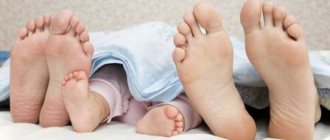Bathing is an important ritual that must be repeated daily. This mandatory procedure helps eliminate dirt and sweat accumulated throughout the day, and also relaxes the muscles well and calms the baby’s nervous system. After water procedures, children, as a rule, eat well and fall asleep quickly. Parents should take care to properly prepare the bathing area and follow safety rules.
Newborn baby in the bath
Features of bathing newborns
Water procedures are a very useful activity for all babies, starting from the first day after birth. The water environment is familiar and familiar to the baby, since he spent nine months in it while he was in his mother’s womb. Newborns feel very comfortable in water. Bathing is a hygienic procedure that is aimed at cleansing the child’s skin and hair of accumulated dirt.
Taking a bath every day promotes the proper physical development of the baby, contains an element of play, and therefore has a beneficial effect on the mental and psycho-emotional development of the child.
Should I bathe with an unhealed navel?
There is no clear answer to this question. Some pediatricians recommend starting to bathe a newborn, even if he has a clothespin on his navel, while others say that it is better to refrain from water procedures until the umbilical cord is completely dry. A well-known pediatrician and author of books on the health and education of children, Evgeniy Komarovsky, says that parents will have to decide whether or not to bathe a newborn in the first days on their own.
Please note! If the child is in good living conditions, does not sweat much, does not overheat, and does not get dirty, then nothing bad will happen to him if he is not bathed in the bathroom for one or two weeks. It won't bother him in any way. If parents are worried that the baby is uncomfortable, they can always wipe the problem areas and folds with wet wipes.
If parents decide to start bathing their newborn baby immediately after discharge from the hospital, then until the umbilical wound heals, this should be done with boiled water without using soap.
Important! Komarovsky does not recommend adding potassium permanganate to water, since it is completely useless in small doses and dangerous in large quantities. It is better to replace it with infusion of string.
Bathing a child with an unhealed navel
Is it possible to bathe a child with a runny nose?
If a runny nose is the only symptom, a ban on water procedures is not justified. On the contrary, a warm bath will help alleviate the child’s condition, you just need to follow some important rules:
- Make sure that the temperature of the water in the bath does not fall below +37-38°C;
- Avoid drafts; the air in the room should be slightly heated before bathing (to do this, you can add a small amount of hot water to the bath);
- If the baby is lying in the bath, then all parts of his body that are not immersed in water must be watered from time to time from a ladle. This is necessary in order to smooth out the difference between the upper and lower temperatures affecting the body;
- Immediately after taking a bath, in order to prevent hypothermia, the child must be dressed in warm pajamas or other suitable clothing;
- It is best for the baby to go to bed immediately after bathing;
- There is no need to wash your baby’s hair unnecessarily, as wet hair may make the runny nose worse;
- It is not necessary to carry out water procedures very often; once every two days will be sufficient;
- The optimal duration of bathing for rhinitis is 7-10 minutes.
Note! When the child is in the bathroom, his respiratory tract will be well moistened and warmed up, as during inhalation. This will reduce swelling of the mucous membrane and strengthen local immunity. If the baby looks lethargic, behaves capriciously, or has an elevated body temperature, then it is better to postpone bathing for a while.
Bathing a child in herbal infusion
When is the best time to bathe a baby?
When is the best time to bathe a newborn? The best time for water procedures is 8-9 pm. After the bath, the baby will get tired, relax, have a good meal and quickly fall asleep until the morning. If the child cannot wait that long and, as a rule, falls asleep much earlier, then parents must adapt to the baby’s biological clock and monitor his behavior. You may need to reschedule your bathing ritual for the morning or afternoon. Once the appropriate time has been determined, it must be fixed and made permanent.
How to develop a child at 4 months - educational games and activities
When to bathe a newborn: before meals or after meals? Some babies like to take a bath before feeding, others - on a full stomach. You can only understand which option is more suitable for the baby and when it is best to feed him through experience. Just a few procedures are enough to find out your child’s preferences and make the right decision. Parents should not ignore a child’s cry; they should always remember that for the baby it is the only way to express dissatisfaction.
Important! Hygiene procedures performed in the evening will help relieve tension, relax and fall asleep. If the baby is very agitated after bathing and does not fall asleep well, it is better to wash him during the day, in between feedings.
An evening bath will calm and relax your baby.
How long after feeding should I bathe?
Parents who do not know how long after feeding a child can bathe should know that immediately after the baby has eaten, it is impossible to wash it - this can cause excessive regurgitation and the appearance of intestinal colic. Pediatricians say that the minimum amount of time that should pass after feeding is 30-40 minutes. How long after eating can you bathe your baby? Ideally, about an hour should pass between the process of eating and hygiene procedures (this time will be enough for some of the food to be completely digested).
Is it possible to bathe before eating?
It is preferable to bathe a newborn before night feeding. But babies are all different: one will be happy to bathe before eating, while another will only be well fed. Parents must take into account the child’s feelings and mood. You should not bathe your baby if he is very hungry and demands food.
In most cases, carrying out water procedures before feeding is the optimal solution. By bathing, the child will not only become clean, but will also perform certain exercises, which are quite expensive in terms of the physical effort involved. It is for this reason that it is more logical to first let the baby get thoroughly tired, only then feed him and put him to bed for a long and sound night's rest.
Dr. Komarovsky recommends following this pattern: bathing, then the last feeding and night sleep. He emphasizes that this approach has obvious advantages: it is gentle on the child’s digestive organs (physical activity does not occur on a full stomach), ease of falling asleep for the child, and long and high-quality sleep at night.
What to do if a child does not like to wash and screams?
Such situations do occur, says Komarovsky. But the point here is not at all about the child and not even about the fact that he is afraid of something. Most likely, according to a famous pediatrician, bathing conditions should be adjusted. Maybe the water temperature does not suit the baby - it is too high or too low for him. After experimenting for several days, parents will be able to understand which water is most comfortable for their child. Bathing should begin with it - and only then adjust the temperature in favor of cooling (adding cold water in a thin stream) or heating (adding hot water in the same way).
We recommend reading: Putting your child to bed early - how to put your child to bed early?
Another reason for a child’s screaming in the bathroom, according to Komarovsky, lies in the baby’s rejection of the bathing process, since it goes against his internal biological clock.
For example, a mother tries to bathe her baby only at night, and it is at this time that the child wants to sleep and not bathe. Therefore, Komarovsky gives some advice that will help parents whose children have trouble in the water:
Change the time of day.
Change your eating and bathing routine. If your baby screams when bathing half an hour after eating, then try bathing him half an hour before eating (or vice versa).
Practice sharing baths with your baby.
How to properly bathe a newborn
A newborn has loose yellow stools - reasons, what to do
In order for the procedure to bring maximum benefit and comfort for the child, parents should take into account some nuances:
- For bathing, it is better to use not a large adult bathtub, but a child’s one, 70 cm long. You can purchase a special anatomical bathtub, which is more convenient for use, since its plane will be located at an angle so that the baby’s head is well kept above the water;
- Before use, you need to wash the bath well with baby soap and pour boiling water over it;
- In order not to worry about the selected water temperature, you can purchase a water thermometer. The water temperature should be 37-38 degrees;
- If there is a need to use herbal decoctions for bathing, you should find out in advance what healing properties each of them has. The decoction should be prepared in advance (an hour before bathing) and added to the bath, straining immediately before bathing;
- In the first month of an infant’s life, you should not use a sponge or washcloth for bathing; it is better to take a soft cloth, a cotton swab, or lightly wash the newborn’s skin with your hand;
- In the process of lowering the baby into the water, you need to hold your head and back with your left hand, and your legs and butt with your right hand;
- Carefully lower the child into the water, holding it so that the head and shoulders are above the surface of the water. Rinse the baby's hands and arms, then the feet and legs.
Additional Information. After bathing, be sure to treat the navel, allowing it to dry. To do this, it is better to use 3% hydrogen peroxide, Chlorhexidine and Miramistin. Drop into the umbilical wound using a pipette. Remove the sodden crusts, but only if they separate well. There is no need to treat the navel with brilliant green. You should not cover your navel with a plaster or bandage, as this can cause the appearance of pathogens and further infection.
Bathing a newborn in a diaper
How to bathe a month old baby
How to properly bathe a one-month-old baby:
- Lower the child into the water with his back down.
- It is important that the baby’s head and neck lie in the palm of mom or dad, and that the shoulder blades and shoulders are in the water.
- For greater convenience, you can use a slide or a hammock so that both hands are free for bathing your baby.
- Using gentle movements, lather the entire body of the child, moving from the neck to the legs. Pay special attention to skin folds, neck, palms, elbow and popliteal fossae, genitals, anus.
- Next, lather the newborn’s head and rinse off the soap.
- At the end of bathing, pour water over the baby, the temperature of which should be one degree lower than in the bath.
Note! Until one and a half months of a child’s life, it is better not to use baby hygiene products (shampoo, foam, gel). If necessary, it is better to use baby soap, but not more than once a week.
One month old baby swims in the bath
Bathing process
How to wash a baby in a baby bath:
- Position the bath so that it is comfortable for mom or dad to keep their back straight for 7-10 minutes. You can conveniently place a baby bath in a large bath using special frames. It is also convenient to use an anatomical bath, in which one tip is slightly raised. This will allow the baby's head to be well supported so that it does not fall into the water. If the bath is ordinary, you can simply place a diaper folded two or three times under the child’s head;
- Prepare the water, bringing it to a temperature of 37-38 degrees. If necessary, you can add a pre-prepared decoction of medicinal herbs to it;
- In the first weeks of a child’s life, it is better to bathe him not naked, but wrapped in a thin diaper - this way he will feel much more comfortable;
- Immerse the baby’s body completely in the bath along with the shoulders, and carefully place the head above the surface of the water, placing it on a folded diaper;
- You can leave the baby in the water for a few minutes or immediately start watering it with water from a ladle. You need to do as the baby likes and constantly monitor the comfortable water temperature;
- If the baby bathes in a diaper, you need to gradually release his legs and arms and lightly wash them;
- After bathing, you should rinse your child with clean water, especially if soap was used for bathing.
Additional Information. You should bathe your child every day, as this is not only an important hygienic procedure, but also gentle hardening.
Baby in a neck circle
Why does a baby scream hysterically during water procedures?
This can happen for several reasons.
To reduce the causes of crying to a minimum, you should properly prepare for water procedures, for this you should:
- make the temperature in the bathroom comfortable for the baby to stay naked;
- heat the water to a comfortable temperature for the baby;
- when immersing the baby in water, it is better to wrap the baby in a diaper, so he will be more comfortable;
- there should be a rag roll under his head, allowing him to hold the baby’s head high above the water;
- the movements of the mother and her assistant when bathing should be smooth, and their speech should be quiet and affectionate;
- Be sure to prepare everything necessary for water procedures in advance so that mom does not leave the bathroom during this process. After all, the loss of the mother from the baby’s sight can also lead to his crying.
A child who is screaming should not be bathed. It is imperative to find out the reason for his screaming and eliminate it. Otherwise, he may hate this process, which will negatively affect his overall health.
One of the common reasons for crying while bathing is a feeling of hunger or thirst. Often they try to bathe infants first and then feed them.
But not all babies are suitable for this regime, and they begin to scream to the point of hysteria. Therefore, if the baby is crying and does not want to bathe, you need to first feed him, and after half an hour bathe him.
Another reason may be rashes that appear on the skin. When they come into contact with water, they can cause discomfort to the child, which causes him to cry. Therefore, before bathing, you need to carefully examine the child’s skin and add herbal decoctions to the water to prevent skin irritation (chamomile, chamomile, etc.).
Also, a baby may cry if his bathing position is uncomfortable, or if his mother does not support him correctly. If this is the cause of crying, you should change the position of the child during bathing.
Crying of a child under 6 months during water procedures occurs quite often. It almost always goes away as the baby grows up.
What to do after swimming
Gymnastics for a 6 month old baby
Actions after swimming:
- Wrap the baby in a towel that will absorb moisture well. It is better to buy a baby towel with a hood so that the baby is warm and his hair on his head dries faster.
- In the first weeks, treat the navel.
- It is good to blot all the folds on the baby’s body, dry the skin with gentle blotting movements, try not to rub it with a cloth.
- Carry out hygiene procedures: clean the ears, treat the skin with powder or moisturizer.
- Put the baby on a diaper and clothes (or swaddle him in a diaper).
Bathing a baby is a special procedure that, apart from some small hassles, will bring parents and the child a huge amount of joy and undoubted benefits, provided that the parents do everything correctly.

